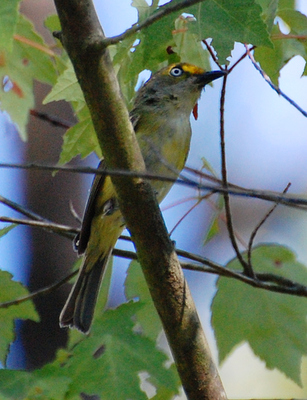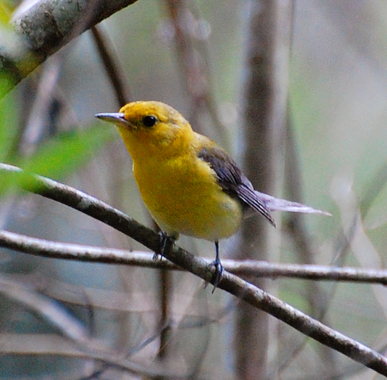
Lifer songbirds in the south
July 10th, 2010
Four new songbirds for me on this trip--a bit of a surprise for a vacation that was centered around the ocean!
1. Seaside Sparrow

This rather drab little bird is a permanent resident in the salt marshes of Outer Banks. Usually a secretive species, one hopped onto a nearby perch and sang (a buzzy, insectile song reminiscent of a Grasshopper Sparrow) while I was photographing the skimmers. I had time for one shot. Poor-quality though it is, the picture plus that song is sufficient to identify him confidently.
2. Prairie Warbler
I found one of these handsome southern warblers when I was hiking Swift Creek Trail in Virginia. It's misnamed--it's a bird of scrubby fields and forest undergrowth, not prairie. Alas, when I went back later with camera in hand, came to what I thought was his territory and pished like crazy, he did not make a second appearance.
Instead, a White-Eyed Vireo answered my pishes by fluttering down into the understory and perching right in front of me. So I photographed him instead :-)

3. Brown-Headed Nuthatch
A bird of southern pine forests. I saw my first on Roanoke Island, where they're abundant (specifically, saw a band of them just outside the Aquarium parking lot). This is Outer Banks' only nuthatch in summer, so the ID was pretty easy. No photo for this one.
4. Prothonotary Warbler
Best for last.

This is one of the most striking warblers there is, and the picture does not do it justice. (For that, click on the above link.) The breeding male is deep golden with a tinge of orange--"marigold yellow", Michael called it. It's also an unusual warbler, being one of only two species who nest in tree cavities: leftover woodpecker holes and the like.
Prothonotary Warblers breed in wooded swamps, primarily in the southeast. I found my lifer, and three more besides, at Alligator River Wildlife Refuge (on the mainland), whose cypress swamps are ideal habitat for them.
July 10th, 2010
Four new songbirds for me on this trip--a bit of a surprise for a vacation that was centered around the ocean!
1. Seaside Sparrow

This rather drab little bird is a permanent resident in the salt marshes of Outer Banks. Usually a secretive species, one hopped onto a nearby perch and sang (a buzzy, insectile song reminiscent of a Grasshopper Sparrow) while I was photographing the skimmers. I had time for one shot. Poor-quality though it is, the picture plus that song is sufficient to identify him confidently.
2. Prairie Warbler
I found one of these handsome southern warblers when I was hiking Swift Creek Trail in Virginia. It's misnamed--it's a bird of scrubby fields and forest undergrowth, not prairie. Alas, when I went back later with camera in hand, came to what I thought was his territory and pished like crazy, he did not make a second appearance.
Instead, a White-Eyed Vireo answered my pishes by fluttering down into the understory and perching right in front of me. So I photographed him instead :-)

3. Brown-Headed Nuthatch
A bird of southern pine forests. I saw my first on Roanoke Island, where they're abundant (specifically, saw a band of them just outside the Aquarium parking lot). This is Outer Banks' only nuthatch in summer, so the ID was pretty easy. No photo for this one.
4. Prothonotary Warbler
Best for last.

This is one of the most striking warblers there is, and the picture does not do it justice. (For that, click on the above link.) The breeding male is deep golden with a tinge of orange--"marigold yellow", Michael called it. It's also an unusual warbler, being one of only two species who nest in tree cavities: leftover woodpecker holes and the like.
Prothonotary Warblers breed in wooded swamps, primarily in the southeast. I found my lifer, and three more besides, at Alligator River Wildlife Refuge (on the mainland), whose cypress swamps are ideal habitat for them.
| ← | → |
